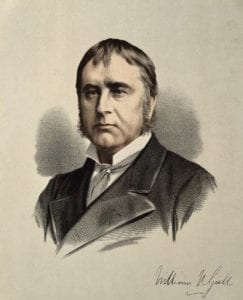 |
William Gull (1816-1890) is remembered by nephrologists as one of the prominent Guy’s Hospital physicians who worked to extend the seminal observations first made by Richard Bright. These investigators worked at a time when blood measurements were not available in clinical medicine and the role of hypertension in causing disease was not appreciated. They tried to understand whether the initial trouble resided in the heart, the kidneys, the blood vessels, or some extraneous toxin, and sometimes argued vehemently in favor of one theory or the other. William Gull, in association with Henry Sutton, postulated that the initiating process was a thickening of blood vessels, as elaborated in their 1872 monograph titled “On the pathology of the morbid state commonly called chronic Bright’s disease with contracted kidney.” Other distinguished physicians from Guy’s Hospital, or elsewhere, took different positions.
But it is by much more than kidney disease that we must estimate the legacy of Sir William Gull. In 1871 he treated the Prince of Wales, who recovered from typhoid fever owing to his “combined energy that never tired, watchfulness that never flagged; nursing so tender, ministry so minute, that in these functions he seemed to combine the duties of physician, dresser, dispenser, valet, and nurse,” – success celebrated by a service of thanksgiving held at St. Paul’s Cathedral and rewarded by his being knighted as well as receiving the appointment of physician-in-ordinary to Queen Victoria. He had a very large and lucrative practice and became one of the richest physicians in London, leaving in his estate 344,022 pounds, an enormous sum for that time. He was one the first to attribute myxedema to atrophy of the thyroid gland. He described in great detail the clinical features of anorexia nervosa and gave it that name; and worked on a variety of conditions such as syringomyelia, brain abscess, cholera, rheumatic fever, intestinal lymphoma, and the various causes of paraplegia. Unaccountably, for he was already an old man at that time, he became victim of a rumor that he had an association with Jack the Ripper or was the murderer himself.
His interesting life and his rise from humble origins and poverty to riches and fame has been subject of many monographs, including one titled Sir William Withey Gull (1816–1890) by Dr. JMS Pearce, a frequent contributor to Hektoen International.
Reference:
JMS Pearce: Sir William Withey Gull (1816-1890). Eur Neurol 2006;55:53–56.
GEORGE DUNEA, MD, Editor-in-Chief
Fall 2018 | Sections | Nephrology & Hypertension

Leave a Reply